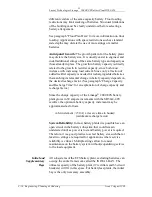
Lucent Technologies Lineage
®
2000 ECS Battery Plant H569-416
Issue 2 August 1996
Engineering, Planning & Ordering 3 - 9
Charge Capacity
and Recharge
Time
For all but batteryless applications, rectifier capacity must be
provided specifically for the recharging of batteries. This
rectifier capacity must be engineered into the plant in addition to
that required to power the load under normal or float conditions.
The sum of the normal and the recharge rectifier capacities is
called the PLANT CHARGE CAPACITY.
The recharge current is a function of the recharge time and
voltage. For example, increasing the plant voltage will decrease
the necessary recharge time and increase current demand.
Increasing the plant voltage after a discharge is recommended by
some battery vendors to assure that all cells charge equally for
maximum life. Although these two charging methods are
essentially the same, they are called by different names. The
former process is called BOOST CHARGING, while the latter
is called EQUALIZE CHARGING. For the purposes of this
manual, the term Equalize is used to indicate boost- or equalize-
charging. Refer to the battery manufacturer's recommendations
on equalize charging.
The recharging requirement is determined by customer practices
and is usually specified as a maximum time to reach a minimum
percent of full capacity, for example, at least 90% capacity in no
more than 24 hours.
o. Maximum recharge time: ____ hours
p. Percent of full-capacity after recharge time (o): ____%
Refer to the Battery manual or other documentation to calculate
the required recharge current to meet the requirements of (o) and
(p). The recharge voltage (m) will be needed for this calculation.
q. Minimum recharge current: ____ amperes
RECHARGE FACTOR is a term that is sometimes used to
describe available recharge capacity. The recharge factor is the
total charge current divided by the List 1 drain. Typical recharge
factors range from 1.20 to 1.50.
r.
Minimum recharge factor: ____
The minimum initial rectifier requirement for float operation is
derived from the Plant List 1 Drains calculated in Table 3-A.
Customer preference MAY dictate any combination of the
following rectifier engineering conventions:
















































